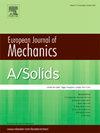Folding pristine paper to an origami structure – materially and geometrically nonlinear finite element analysis
IF 4.4
2区 工程技术
Q1 MECHANICS
引用次数: 0
Abstract
Cellulose-sheet-based origami packaging structures represent a promising solution for advancing environmental sustainability while meeting the growing demand for high-performance, functional, and personalized packaging. While significant progress has been made in modeling the mechanics and transformations of origami with pre-defined fold lines, as well as in the constitutive modeling of paper, there is limited research capturing the detailed physical transformation process from a pristine sheet to an origami structure. In packaging and converting, pre-treating fold lines is a common practice to define fold location and quality. However, leveraging the full range of manufacturing possibilities for origami requires a fundamental understanding of fold-line formation in non-trivial fold networks, where a pristine (no mechanical pre-treatment of creases) sheet is a starting point in folding. This study employs finite element modeling to systematically investigate the formation of Miura-ori-family-based structures in cellulose sheet materials with orthotropic, nonlinear constitutive behavior. The results reveal how tessellation parameters, material properties, and imperfections influence folding mechanics and the pristine formation of fold lines near fold intersection points.
基于纤维素片材的折纸包装结构是一种很有前途的解决方案,既能促进环境的可持续发展,又能满足人们对高性能、功能性和个性化包装日益增长的需求。虽然在使用预定义折叠线对折纸的力学和转换进行建模以及在纸张的构成建模方面取得了重大进展,但捕捉从原始纸张到折纸结构的详细物理转换过程的研究却十分有限。在包装和加工领域,预处理折叠线是确定折叠位置和质量的常见做法。然而,要充分利用折纸的各种制造可能性,就必须从根本上了解非三维折叠网络中折叠线的形成,而原始纸张(无机械预处理折痕)是折叠的起点。本研究利用有限元建模系统地研究了纤维素薄片材料中基于三浦ori族结构的形成,这些材料具有正交非线性构成行为。研究结果揭示了细分参数、材料特性和缺陷如何影响折叠力学以及折叠交点附近折线的原始形成。
本文章由计算机程序翻译,如有差异,请以英文原文为准。
求助全文
约1分钟内获得全文
求助全文
来源期刊
CiteScore
7.00
自引率
7.30%
发文量
275
审稿时长
48 days
期刊介绍:
The European Journal of Mechanics endash; A/Solids continues to publish articles in English in all areas of Solid Mechanics from the physical and mathematical basis to materials engineering, technological applications and methods of modern computational mechanics, both pure and applied research.

 求助内容:
求助内容: 应助结果提醒方式:
应助结果提醒方式:


